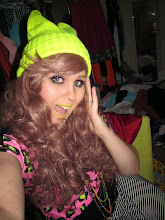The Kid Stays in the Picture had a very interesting visual style in my opinion. I liked how most of the people were snapshots put in AfterEffects versus moving, speaking people. It intrigued me how many scenes, background were filmed. But then again, it makes sense why the people would be photographs since this is a biography and all in the past. But instead of a boring TV documentary, this one attempts to have creative and artistic points all throughout the film. It does have that classic disembodied voice of documentaries, the narrator. However, knowing that it is Evans talking and seeing the way the still images were manipulated into dynamic imagery, it brings the voice a little closer to being believably realistic.
In the Realms of the Unreal had more actual animation than the afore mentioned film. The scene with the nun's face turning into a bulldog's was particularly interesting and caught my eye. I guess one would have to wonder of the necessity of animation in both of the films. It seems like in In the Realms of the Unreal it is very plausable because animation allows for things (like transformation) that just don't happen in real life. While both are documentaries, the viewer knows that the subject, Henry, of this film is psychologically unstable and lives often in an imaginary world. So why not have nuns who turn into bulldogs? But the previous film was hard and fast to history and lacked imaginary elements. Which is not a bad thing per se. Imaginary things just didn't fit the bill.
Ken Burns' The Civil War has one really distinct artistic feature to it. Almost all the pictures fade between each other (quickly to black and then to the next picture) along with the camera surveying the images or hopping up and down as if on shaky ground.
Ideas:
1) This may a bit broad and I might want to break it down further, but I'm interested in exploring one of animation's key components, transformation. Only in this realm can this happen without question or explanation. It's just accepted as the truth of that imaginary world. I would like to explore what is transformation, what can transformation become, what purpose transformation has, and what it provides for us as viewers and artists. I also would like to see what the causes of transformation are; Are they natural, necessity, comedy, imaginary? Why does transformation happen and is it real even in the realm of animation, i.e. is it fiction even for the characters involved? And even without a narrative, transformation has what role and can teach/tell/provide us with what?
Does transformation have a purpose? What is there to gain?

Does transformation have to be realistic? What kind of transformation IS realistic and how has it been applied elsewhere?


2) Once again a tad broad possibly, but I want to potentially understand imagination itself. Why do we have it in the first place and what does that say about us? How does our imagination makes us differ from person to person and what does it provide us as people? Are our lives richer because of it? Is it a place to escape to or somewhere to avoid? And when does it cross the line? When does imagination BECOME reality? (Space ships were once a figment of the imagination but now are common. Or from another angle, when does someone's imagination take over to the point that reality for them is filled with figments developed from their mind?) Finally, when can imagination benefit or weigh down a person/society?
When does imagination cross over into reality or vice versa?

3) Lastly, I potentially want to explore the concept of isolation. Isolation does not have to necessarily be a bad thing. Sure, it can mean keeping to one's self but I would like to see the concept explored in the sense of isolating elements such as color, shapes, light, etc. and how that plays in with animation or film. How does dividing colors instead of letting them blend effect an image? What is the mood/feel/outcome/purpose of isolating light to one space? How is the screen affected by shapes kept isolated from one another or one odd one out? Even further I want to explore the reactions of the eye to these isolations. Does the isolation always have to stand out? Or can it occur without even one knowing? Do you have to work to find it or is obvious?




No comments:
Post a Comment